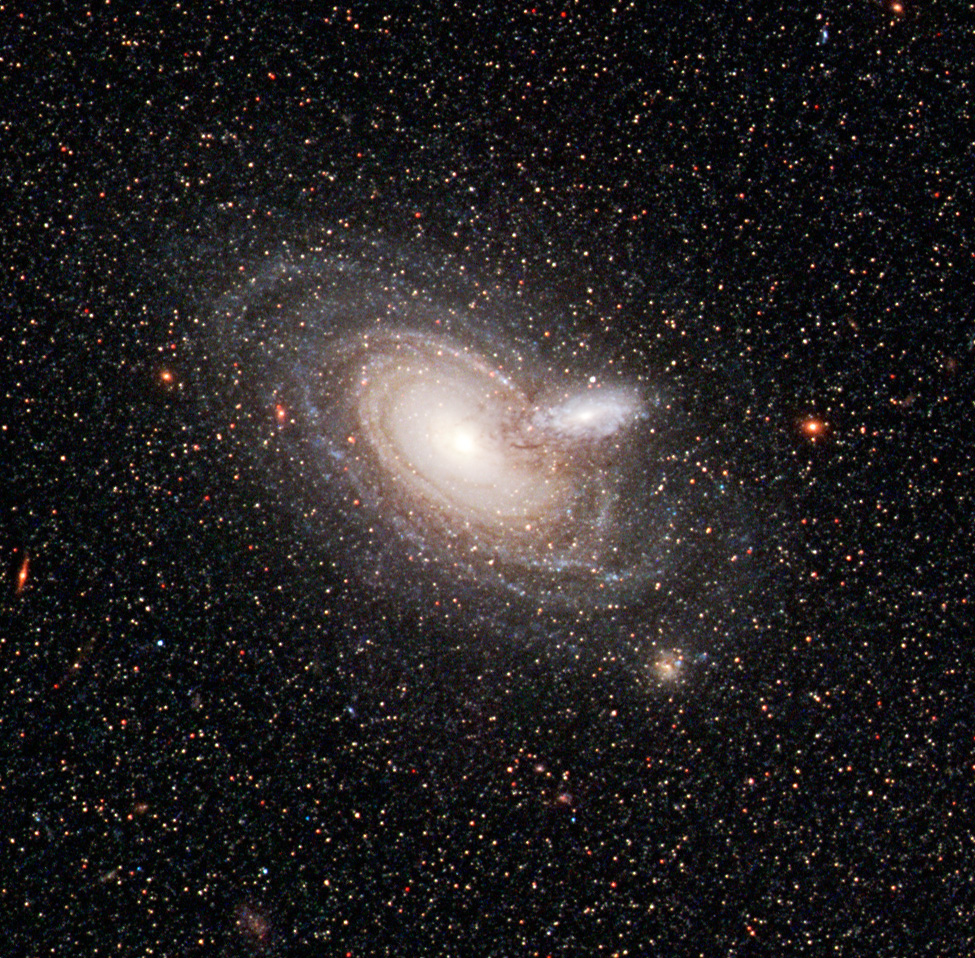This Hubble Space Telescope image of two spiral galaxies shows an interesting feature on the smaller galaxy. Silhouetted in front of the larger background galaxy is a small galaxy, and tentacles of dust can be seen extending beyond the small galaxy’s disk of starlight. These dark, dusty structures appear to be devoid of stars, almost like barren branches. They are rarely so visible in a galaxy because there is usually nothing behind them but darkness. But here, with the backdrop of the larger galaxy they are illuminated. Astronomers have never seen dust this far beyond the visible edge of a galaxy, and they don’t know if these dusty structures are common features in galaxies.
The background galaxy is 780 million light-years away, but the distance between the two galaxies has not yet been calculated. Astronomers think the two are relatively close, but not close enough to actually interact. The background galaxy is about the size of the Milky Way Galaxy and is about 10 times larger than the foreground galaxy. Understanding a galaxy’s color and how dust affects and dims that color are crucial to measuring a galaxy’s true brightness. By knowing the true brightness, astronomers can calculate the galaxy’s distance from Earth.
Most of the stars speckled across this image belong to the nearby spiral galaxy NGC 253, which is out of view to the right. Astronomers used Hubble’s Advanced Camera for Surveys to snap images of NGC 253 when they spied the two galaxies in the background. From ground-based telescopes, the two galaxies look like a single blob. But the Advanced Camera’s sharp “eye” distinguished the blob as two galaxies, cataloged as 2MASX J00482185-2507365. The images were taken on Sept. 19, 2006.
Source: Hubblesite


Can’t see the picture…
working on it……
Nancy
Astronomers just found Cthulhu… 😀
No Jorge, its the Flying Spaghetti Monster!!!
😀
They found Dark Matter!!! 😉
Yes. It must be a disk of dark matter. Like they predicted, also in the news today.
Beautiful image. I must say that some of my favourite Hubble shots are those of galaxies in silhouette against background galaxies. Gotta love the backlighting for observational purposes!
Interesting! Could the dark region of the subject be analogous to the ‘metal filings’ outline of the magnetic field of a childs simple ‘horse shoe magnet?’ Where in this observation, the ‘metal filings’ analogy could be mysterious dark matter responding to gravity. Occum’s razor.
There’s your 22% of missing matter, right there!
Ah! another mystery, and a beautiful picture to boot. Joy.
The starless dust and gas field around the smaller galaxy is almost the exact same size as the Dark Matter map article from a few days ago.
I’m a little surprised that this has not been seen before as I imagine it was expected there would be a thin halo of dust and gas around galaxies.
Without tentacles, how would they do tentacle sex scenes?
The ‘dark matter’ in the foreground spiral seems to me to be ordinary gas & dust in the outer disk of this spiral. As seen without the background spiral, this galaxy would probably look like any ordinary Sb or SBb galaxy with its’ extended disk.
The ancient Greek’s thought Zeus sat on Mount Olympus throwing lightning bolts. Astronomers see extra gravity, and they invent mythical dark matter. Now they can see an example of what is likely to be the cause for the observed, but unexplained, gravity. Astronomers already ruled this out because they couldn’t see it, and now it will take an entire generation before opinion comes around because careers and money are wrapped up in dark matter research. Eventually this will look as silly as cold fusion, flat Earth, Moon hoax, etc.
Interesting; detailed yet obscure. More work and examples required. No comment yet.
So long ago and far away.
Where are our mind-over-matter astro-probes? Calling all DarkMatter entities! Reveal yourselves, please!
Ok… That’s a cool picture but I doubt that this is “Dark Matter” or an explanation for this missing “Dark Matter” people have been looking for…. It seems the article states the tentacles are “rarely so visible” which also implies this phenomena has been seen before… maybe not to the same extent??
I think Dark Matter is supposed to be something exotic and mysterious… like the Flying Spaghetti Monster intended!!!
I’m certain that the image noted above is not the first ever of a galaxy superimposed on another, but it definitely has great detail. I did a quick search on the APOD website and came up with an image of Abell 2218 which also appears to have a galaxy superimposed over another, with the dust filaments included. I don’t think I can post the link here, though; I tried and I think a filter saw a link and deleted it.
With the power of a billion suns in the background absorbing (or blocking) light in the foreground, how could anyone imagine this is not something exotic. When you are in the forest looking at a tree, you may not know it’s a forest until you see the whole forest. It could be the reason we do not see ‘layers’ between the spiral arms here at home. I for one, say “It is dark matter”.
2 images of superimposed galaxies immediately come to mind. Check out Hubble images of NGC 2207/IC 2163 & NGC 3314a/NGC 3314b. I also seem to recall seeing several other examples of superimposed galaxies detected ovey the past 10-20 years, so this image, beautiful as it is, is certainly not the first of its type & almost certainly NOT a direct image of Dark Matter.
Andrew, you mean this one?
http://apod.nasa.gov/apod/ap011007.html
There’s a head-on spiral there over one of the reddish gravitationally lensed arcs, but the detail is quite low (as would be expected, since Abell 2218 is very far away)